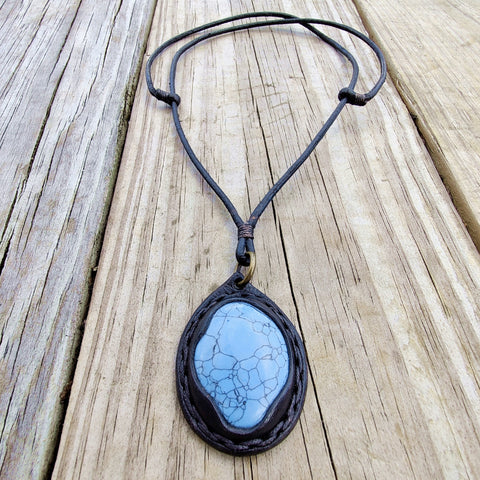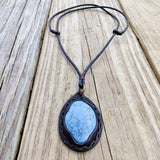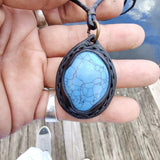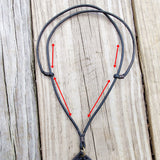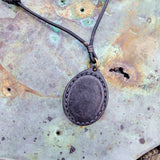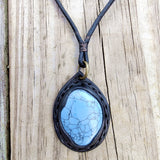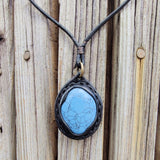Boho Leather Necklace with Turquoise Stone setting.
Cutting, dying and stitching-braiding are %100 handmade, we use quality vegetal genuine leather on our products.
The pendant is attached to an adjustable leather strap and is %100 handcrafted.
Turquoise is perhaps the oldest stone in man’s history, the talisman of kings, shamans, and warriors. It is a stone of protection, strong and opaque, yet soothing to the touch, healing to the eye, as if carved from an azure heaven and slipped to earth. Its unique shade of blue, often blue-green, lends it name, Turquoise, to all things of this tranquil hue. The delicate veining or mottled webbing in cream or brown is inherent to the stone and serves to enhance its character.
The name Turquoise is derived from the French, pierre turquoise, meaning “Turkish stone,” because the trade routes that brought Turquoise to Europe from the mines in central Asia went through Turkey, and Venetian merchants often purchased the stone in Turkish bazaars. [Simmons, 419]
For thousands of years, Turquoise has spanned all cultures, prized as a symbol of wisdom, nobility and the power of immortality.[Eason, 239] Among the Ancient Egyptians, Persians and Chinese, Aztecs and Incas of South America, and Native North Americans, Turquoise was sacred in its adornment and for power, luck, and protection.
Turquoise beads dating back to 5000 B.C. have been found in Iraq, and the Egyptians were mining the stones in the Sinai in 3200 B.C. [Simmons, 419] The death mask of Tutankhamun was studded with Turquoise, as were the mosaic masks dedicated to the gods, the fabulous inlaid skulls, shields and power statues of Moctezuma, the last ruler of the Aztecs. [Eason, 239]
For nearly a thousand years, Native Americans have mined and fashioned Turquoise, using it to guard their burial sites. Their gems have been found from Argentina to New Mexico. [Simmons, 419] Indian priests wore it in ceremonies when calling upon the great spirit of the sky. Many honored Turquoise as the universal stone, believing their minds would become one with the universe when wearing it. Because of its ability to change colors, it was used in prophesy or divining. To the prehistoric Indian, Turquoise, worn on the body or used in ceremonies always signified the god of the sky alive in the earth. [Mella, 111]

